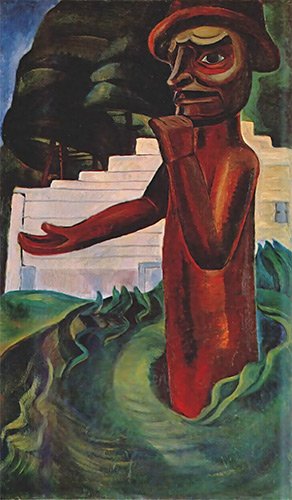Emily Carr, 1871-1945
By Kayleigh Wiseman
Potlatch Welcome, 1928, oil on canvas
Emily Carr is considered a Canadian National Treasure, a cherished icon of Canadian arts and letters. Her life, both personal and artistic, was inspired by the coastal environment of British Colombia and the cultures of its native peoples.
Emily Carr was born on December 13th, 1871, in Victoria, British Colombia, the second youngest of nine children. Her father was a huge source of inspiration, encouraging her independent spirit and artistic pursuits. After her parents passed away, Carr decided to pursue art seriously and studied at the San Francisco Art Institute in 1890. However, she left the Institute early and returned to Victoria in 1892 to start teaching art classes in her local studio, a pursuit Carr continued throughout her life.
In 1899, Carr started studying at the Westminster School of Art in England. However, her independent and adventurously rebellious spirit found the English education conservative and she left after only two years. Over the next twelve years, Carr moved and travelled from Victoria to Europe, studying with different international artists including Julius Olsson and John Whiteley.
Carr officially returned to British Colombia in 1912 and marked her homecoming with an exhibition at her studio. The exhibition featured seventy watercolour paintings that she completed in France under Harry Phelan Gibb. Carr was the first artist to introduce Fauvism to Canada, which made her work ahead of its time and unfamiliar to many in the art world for years. Due to tragically little attention, Carr took a hiatus from pursuing her artistic career, working as a dog breeder and boarding house landlady for a decade.
In 1927 Carr’s artistic career was revived when she was invited by the National Gallery of Canada to participate in an exhibition on Canadian West Coast Art: Native and Modern. During the show in Ontario, Carr met the other members of the show, who became known as ‘The Group of Seven’, including fellow artist Lawren Harris, whose encouragement and support were momentous in Carr’s artistic and personal life. Her engagement with the group refueled her love for the arts, and the group declared her ‘The Mother of Modern Arts’.
Carr continued to travel around Canada, immersing herself in the living cultures of the First Nations and recording her experiences through her paintings. Carr’s most notable works capture the spirit of Canada's vast nature through a modern style. Employing a Fauvist bright colour palette to depict forests, water, totem poles, First Nation peoples, and culture. The Nuu-chah-nulth of Vancouver Island's west coast were extremely fond of Carr and her work and bestowed upon her the native name ‘Klee Wyck’, meaning ‘the laughing one’. Carr titled her first book Klee Wyck, which was a record of her experiences travelling around the First Nations. Published in 1941, the book won the Governor General's Award that year. Due to a poor heart, Carr began to write more than she did paint after her first heart attack in 1937. After years of ill health, Carr passed in 1945. Just before her passing she was awarded an honorary doctorate from the University of British Colombia, a final tribute for a great Canadian artist.
Bibliography
Linsley, Robert. “Landscapes in Motion: Lawren Harris, Emily Carr and the Heterogenous Modern Nation.” Oxford Art Journal 19, no. 1 (1996): 80–95. https://doi.org/10.1093/oxartj/19.1.80.
Pagh, Nancy. “Passing Through the Jungle: Emily Carr and Theories of Women’s Autobiography.” Mosaic: An Interdisciplinary Critical Journal 25, no. 4 (1992): 63–75. https://doi.org/https://www.jstor.org/stable/24780556.

